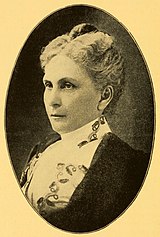S. W. T. Lanham
Samuel Willis Tucker Lanham | |
|---|---|
Thomas H. Ball | |
| Constituency | 8th district |
| In office March 4, 1883 – March 3, 1893 | |
| Preceded by | District created |
| Succeeded by | William H. Crain |
| Constituency | 11th district |
| Personal details | |
| Born | Samuel Willis Tucker Lanham July 4, 1846 near Confederate Army |
| Battles/wars | Battle of Spotsylvania Court House, Civil War |

Samuel Willis Tucker Lanham (July 4, 1846 – July 29, 1908), was the
Early years
Samuel Willis Tucker Lanham was born in 1846 in South Carolina to James Madison and Louisa de Aubrey (Tucker) Lanham in Spartanburg District (now County), South Carolina, and named for his maternal grandfather, Samuel Willis Tucker. When the Civil War began, Lanham volunteered for the Confederate States Army, despite the fact that he was only fifteen years old. He fought primarily in Virginia, was wounded at the Battle of Spotsylvania Court House,[2] and after hostilities ended he married. He and his wife settled in Weatherford, Texas, where he worked and studied law.[3]
Shortly after he was admitted to the bar in 1869, Lanham was appointed district attorney. His most famous case was the prosecution of
In 1882, Lanham was elected to
Governor
Lanham was elected
The
Lanham took the lead in tax reform in 1905. Under the existing Texas system, the bulk of the state's income came from a general property tax, but it did not provide the amount of revenue the state wanted to spend and so, at Lanham's request, the legislature began taxing the gross receipts of express companies and pipelines. The legislature also raised taxes on intangible assets of the railroads and other industries.[4]
The legislature also took efforts to reform election laws during Lanham's term. Before he took office, there was not a set procedure for nominating candidates for public office, which led to a great deal of fraud and many shenanigans meant to keep people from voting. The legislature passed two election reform laws during Lanham's administration, both named after their author, Judge Alexander W. Terrell. The first law, passed in 1903, allowed political parties to nominate candidates by either a convention or a primary election. The second law, in 1905, established voter qualifications, required candidates to file itemized expense statements, required primary elections for major parties (at this time, only the Democratic party was considered a major party in Texas), and set a uniform date for primaries.[4]
Near the end of his second term, a large political scandal erupted, Before he took office, the state had filed a lawsuit against
Lanham did not enjoy his time as governor, often wishing that he had remained in Congress. He said that "'office seekers, pardon seekers, and concession seekers overwhelmed me. They broke my health'".[6]
After leaving office, Lanham retired to Weatherford, Texas, where he died in 1908.[6]
Other
Samuel W.T. Lanham was a
He was considered an eloquent speaker and writer, and often made speeches at Confederate veterans' camps throughout Texas. In 1868, he joined the Masons. He received an honorary doctorate from Baylor University in June 1905. Governor Thomas M. Campbell appointed him a regent of the University of Texas in 1907.[2]
Lanham's son
Notes
- ^ "S. W. T. Lanham". Biographical Directory of the United States Congress.
- ^ a b c S. W. T. Lanham from the Handbook of Texas Online
- ^ a b c d e Hendrickson (1995), p. 140.
- ^ a b c d Hendrickson (1995), p. 142.
- ^ Hendrickson (1995), p. 143.
- ^ a b Hendrickson (1995), p. 144.
References
- Hendrickson, Kenneth E. Jr. (1995), The Chief of Executives of Texas: From Stephen F. Austin to John B. Connally, Jr., ISBN 0-89096-641-9
External links
- S. W. T. Lanham from the Handbook of Texas Online
- Phoenix Lodge #275, Grand Lodge of Texas


